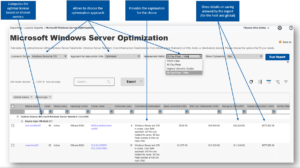Microsoft recently made significant changes to its licensing policies for Windows Server 2022. By removing specific requirements and aligning licensing with actual core counts, Microsoft aims to address licensing complexities and more effectively compete for market share against Linux and other competitors. These changes also allow additional opportunities for organizations to optimize their spending on Microsoft licenses.
Cost-saving opportunities
Organizations should review these changes and consider optimizing their Microsoft Windows Server licensing strategies to leverage the benefits of cloud services and explore alternative options if deemed suitable. The alterations include:
- Offering the option to license Windows Server Standard “per VM, with a minimum of 8 cores.” This evolution results from the October 2022 changes that included a mobility right for licenses with Software Assurance (SA) (“within server farm”). In short, the 90-day license assignment (AKA mobility) rule is optional for customers with SA.
- Permitting organizations to use standard licenses with Windows Server Datacenter virtual machines, when allowed through cloud service providers.
- Allowing organizations to match the actual core count of a VM to the licensed cores, eliminating the need for unnecessary licenses. Previously, the Azure Hybrid Benefit mandated that Windows Server Core licenses be grouped into eight sets when licensing a virtual machine with more than eight cores. For example, a 20-core VM required three sets of eight licenses (24 licenses total), resulting in four wasted licenses.
- Allowing organizations that obtain Windows Server subscriptions through cloud service providers to use standard licenses with Windows Server Datacenter virtual machines. This practice was already in place when using on-premises VMs or working with an authorized outsourcer, but it is now officially recognized and supported.
These modifications provide organizations with cost-saving opportunities and encourage the adoption of cloud services. Although not publicly announced, these changes were quietly updated on the Product Terms page.
Are these changes just a gift from Microsoft to its customers?
Simplifying the licensing rules and enhancing customer satisfaction is certainly a laudable driver for these new rules.
- True-ups were a nightmare for Windows Server due to the complexities of calculating license consumption. The 90-day license assignment rules forced a “worst case” approach for customers who do not have the Flexera solution that captures the 90-day peaks, triggering complex calculation. The “blocks of 8 cores” for Azure were also adding additional manual work.
- These rules were adding extra costs. The “worst case” approach leads to licensing in 90 percent of the cases of all ESX servers’ cores in a cluster (similar to Oracle’s difficult soft partitioning rule). Also, the concept of blocks of cores forces rounding up the consumption.
There are other “political” reasons behind these smoother rules:
- Microsoft fiercely competes in the operating system market. In 2020, the number of cores of Linux VMs was more than half of all Azure VM cores. Windows Server has to be competitive and cost is a major consideration.
- Microsoft has a vested interest in moving customers to Azure. Cloud expenses are exploding because the flexibility and scalability of the cloud leads to significant waste, with unused instances that still require subscriptions of Windows Server licenses. The pricing strategy appears to be a way to gain market share by charging less for Windows Server per cloud instance.
- The new benefits come with a 10 percent price increase, consistent with the average yearly price increase for Windows Server licenses.
Preparation starts now
Organizations under a Microsoft Enterprise Agreement (EA) receive price protection and locked-in use rights and terms for at least three years. However, when it comes time for renewal, companies must review and mitigate the risks associated with three years’ worth of changes. This highlights the importance of starting the preparation process early.
The October 2022 and April 2023 changes require no change for Flexera customers to be fully supported. Flexera implemented the optimization capabilities to take advantage of these rule changes so customers can immediately begin reaping the cost savings available from these new benefits.
How to save millions on Microsoft
IDC predicts Worldwide Server Market Spending will grow 7.7 percent CAGR over the next five years. As a part of this, the Microsoft server market remains vibrant and critical.
In light of these licensing changes, organizations should carefully assess their Windows Server licensing strategies. Removing specific requirements opens possibilities for optimizing costs and utilizing cloud services.
Consider the following steps to maximize cloud spending in the wake of Microsoft’s recent changes:
- Have the best data: Leverage your ITAM solution to understand what you have in your environment across cloud, on-premises and SaaS. Understand your contracts, as well as your usage and consumption.
- Evaluate your VM deployment: With the minimum core license requirement eliminated, reassess your VM deployment strategy to leverage the benefits of the Azure Hybrid Benefit and cloud services.
- Use the Flexera One Windows Server Optimization reports: These compute the optimal license consumption comparing the three available options: Windows Server Datacenter (Optimal for “high density clusters,” Windows Server Standard per Hosts (90-day VM peak, optimal for VMs with high core numbers) and Windows Server Standard/VM (often optimal for low-density clusters).
- Review your licensing agreements: If you license Windows Server through cloud service providers, ensure you know the updated licensing terms and take advantage of the ability to use standard licenses with Windows Server Datacenter virtual machines.
- Consider alternative options: While Windows Server remains a dominant player, Linux continues to gain market share. Assess if Linux-based solutions can meet your organization’s requirements and provide cost savings.

The power of Flexera One ITAM
One of the top priorities of ITAM teams is to save money. Optimizing spend (across cloud, on-premises and SaaS) is also a driving factor, with the goal of improving budgets. But the blueprint provided by ITAM also has a wider reach, delivering value for initiatives related to security; IT service management (ITSM); planning; budgeting; regulatory requirements; environmental, social and governance (ESG); enterprise architecture and beyond. When ITAM is used in conjunction with FinOps (the practice of cloud financial management), companies have the opportunity to truly optimize their IT estates—and savings.
A mature ITAM program enables an organization to have full visibility into its IT assets so it can cost-efficiently use those assets. It also enables the organization to track end of service/support (EOS) and end of life (EOL) of these assets. This allows an organization to proactively identify potential issues (performance and/or contractual) before they arise.
The technology landscape is changing rapidly. Digital transformation pressures are mounting. The highest-functioning enterprises are leaning on ITAM practitioners who face new and evolving challenges across public cloud, hybrid cloud and SaaS technologies.
Flexera One lets enterprises visualize their entire technology estate, from on-premises to SaaS to the cloud. And it delivers the power to mitigate risk, reduce costs and maximize every technology investment—so you can invest in innovation.
IT Asset Management
It all starts with knowing what’s in your IT ecosystem. Flexera One discovers even the most elusive assets whether on-prem, SaaS, cloud, containers and more.
It matters to the bottom line. The most advanced users of ITAM save millions of dollars by knowing their actual consumption and comparing it to technology agreements. Savings can be invested in R&D and innovation.
It’s time to radically rethink your relationships with your technology suppliers
Put your organization in a position of greater control before the next software vendor or cloud provider announces changes that impact your usage costs and your bottom line. And arm yourself with the comprehensive cost and usage data that gives you an advantage when you sit down at the technology negotiation table.
Find out how: https://www.flexera.com/blog/technology-value-optimization/radically-rethinking-your-technology-supplier-relationships/







